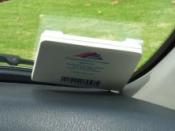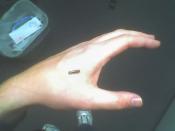Introduction
Businesses, today, are researching ways to improve their daily processes, both logically and physically. This may include better reporting of profit and loss, return on investment using a low cost technological solution. Radio Frequency Identification Device (RFID) is one technology that many companies are considering implementing.
Description of Radio Frequency Identification Device (RFID)
Department of Homeland Security defines Radio Frequency Identification Device (RFID) as "wireless systems that allow a device to read information contained in a wireless device or "tag" - from a distance without making a physical contact or requiring a line of sight between the two. RFID provides a method to transmit and receive data from one point to another." RFID is an automatic identification method relying on storing and remotely retrieving data using devices called RFID tags or transponders.
Historically, the RFID technology was around in 1920s; however, the first known device was invented in 1945 and was said to be used as an espionage tool; however, this tool was just a listening device and not an ID tag. The actual RFID system was developed around 1960s.
RFID System
The RFID System includes the tags, transponders, transceivers and application to retrieved and read data from tags to transponders and application software. Additionally, the human component must be skilled and trained for the application.
RFID Tags
The RFID tag is a small object that can be attached to or incorporated into a product, animal, or person. There are three types of tags: passive, semi-passive and active. The passive tag uses no internal power. This tag is powered when radio frequency signal sends the electrical current to the internal circuit of the tag to transmit a response and holds an identification number only. Due to the lack of onboard power, the passive tag can...


